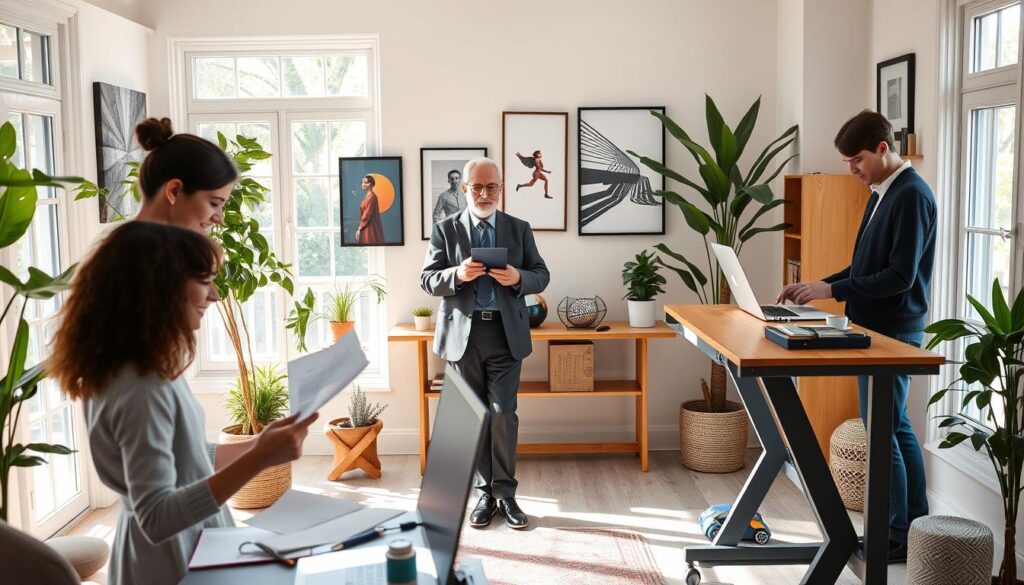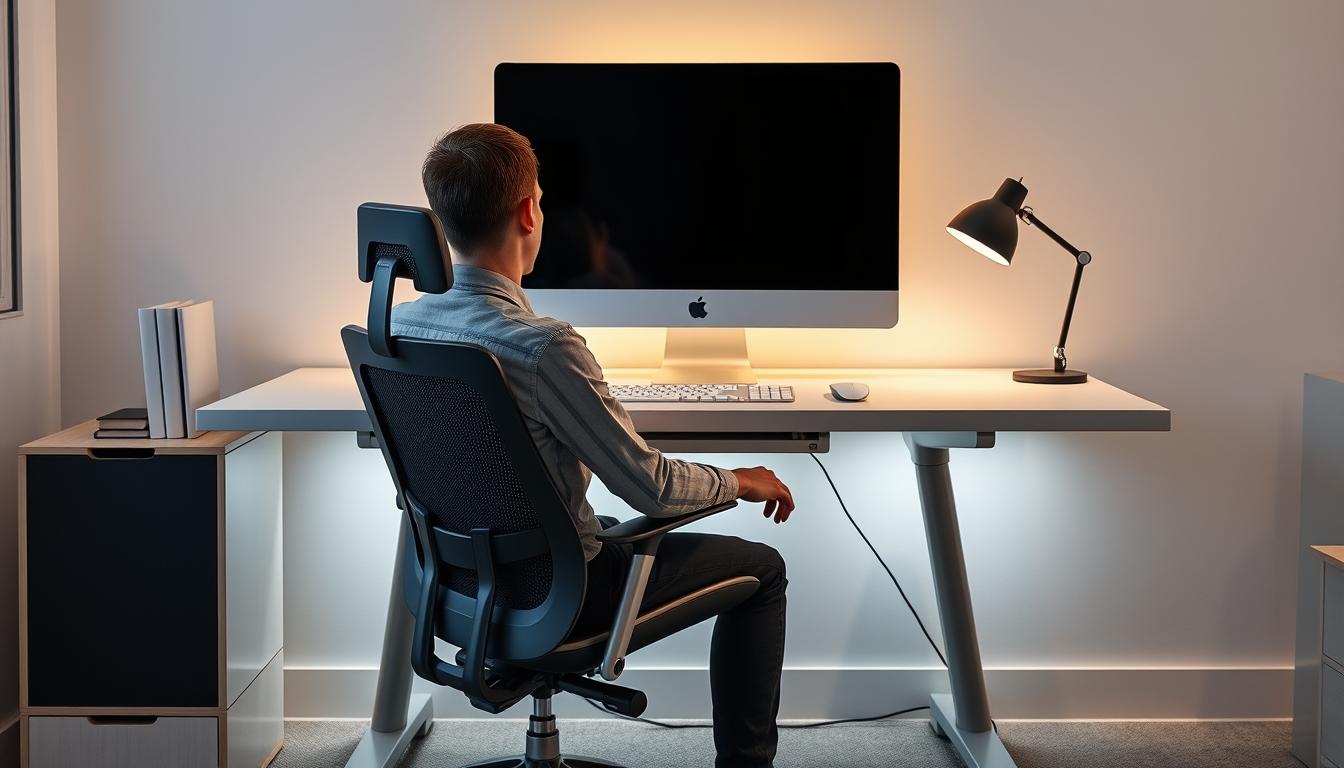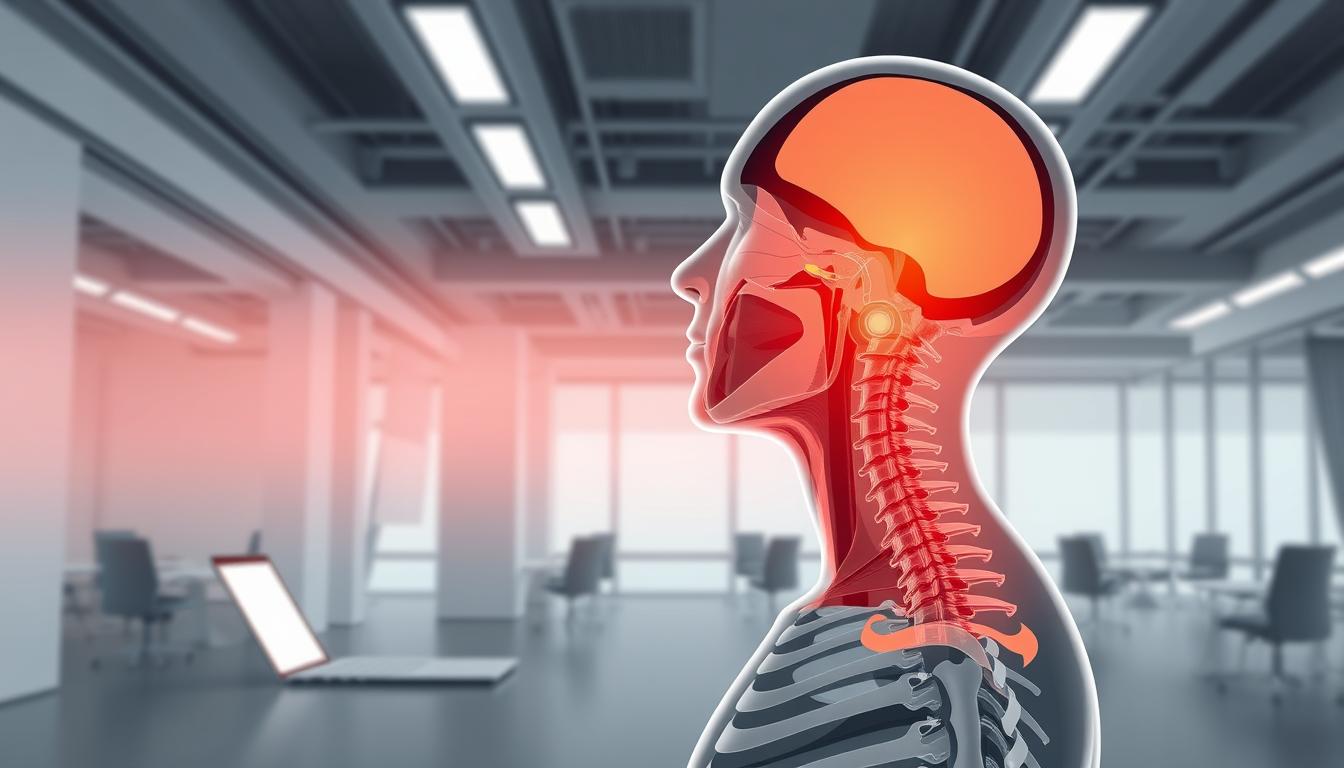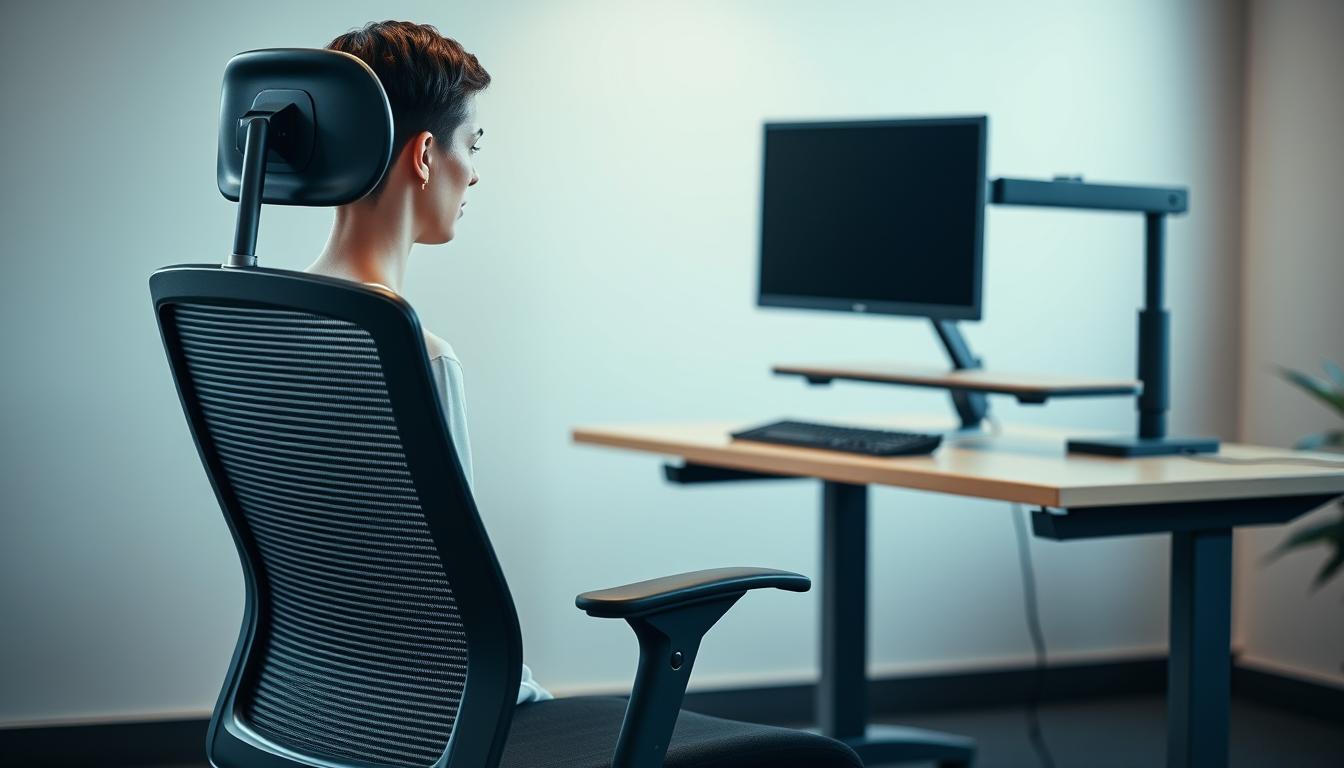Today, most of us sit too much and it’s not good for our health. Standing desks are a great way to help. They relieve neck pain and help us stand straighter. By standing instead of sitting, we can make our spine happier and reduce pain. This section will show you how a standing desk can make you feel better. You’ll learn why sitting too long is bad and how standing desks can help.
The Impact of Sedentary Lifestyles on Neck and Back Pain
Many people, especially office workers, live sedentary lifestyles nowadays. This means they sit a lot, which can be bad for their health. It can cause neck and back pain. It’s important to understand how sitting too much affects us.
Understanding Prolonged Sitting
Studies show that office workers often sit for about 70-80% of their working hours. Sitting too much can lead to muscle issues and other health problems. One major issue is that it changes the way we hold our heads and backs. This bad posture puts pressure on the neck. Over time, this can lead to ongoing pain in both the neck and back.
Association with Musculoskeletal Disorders
Sitting for too long is linked to muscle and bone problems. It stops the spine from being properly aligned, causing neck and back discomfort. If we don’t change our sitting habits, these issues could turn into long-term problems. This can increase our chances of getting hurt. People with neck pain can end up in a cycle that makes their life harder. Fixing these problems early can help improve health and reduce pain.
What is a Standing Desk?
A standing desk lets you work on your feet. It’s a fix for too much sitting, linked to health problems. These desks are now part of comfy, health-focused workplaces.
Types of Standing Desks
When picking a standing desk, knowing the types helps. You’ll find:
- Adjustable Desks: These change in height, so you can stand or sit. They encourage movement, keeping you comfy all day.
- Fixed Desks: These desks stay at one height. They’re good for those who like a steady work surface.
Adjustable vs. Fixed Desks
Your choice between adjustable and fixed desks is personal. Adjustable desks are good for changing postures. They help avoid the issues of sitting too long. Fixed desks work for those happy at one height. The best choice depends on what feels right to you, aiming for comfort and productivity.
Standing Desk Benefits for Neck and Back Pain
Switching to a standing desk helps fight neck and back pain in many ways. These desks do more than make you comfortable. They can make your posture better and boost how much you get done each day. By making your spine line up right and making muscle tiredness less, these desks are great for easing pain from sitting too long.
Improved Spinal Alignment
Standing desks are great for keeping your spine straight. When you stand, your spine stays in a natural position, unlike when you sit and might slouch. This better posture lowers stress on your spine and muscles. It helps keep your back healthy over time.
Reduction in Muscle Fatigue
Standing desks cut down on muscle tiredness, especially in your upper back and shoulder area. Sitting for too long strains these muscles, causing tension and soreness. Standing helps use your muscles in a new way. This increases blood flow and lessens tiredness during the day.
Alleviation of Discomfort
People find a lot of comfort moving to a standing desk. It lessens pressure on your lower back and boosts blood flow. This decrease in pain and discomfort comes from not sitting for too long. Standing desks are key in dealing with and avoiding muscle and bone issues from not moving much.
How Standing Desks Improve Posture
Standing desks help improve our posture, especially by positively affecting the craniovertebral angle (CVA). This angle measures how well our head and neck line up. Many people, especially those sitting for long periods, end up with a forward head posture. This can cause neck and shoulder discomfort.
Using a standing desk can help lessen these problems. It promotes better overall health in how we sit and stand.
Significance of Craniovertebral Angle
The craniovertebral angle shows if our head and neck are aligned correctly. Good CVA helps support the spine and eases muscle tension. Standing desks allow us to keep our heads in a neutral position.
This can lead to a better craniovertebral angle. It lessens neck strain and lowers the chance of chronic pain from bad posture.
Forward Head Posture and Its Effects
People who sit a lot often develop forward head posture. This misalignment negatively affects our health. It puts extra stress on our neck, leading to discomfort and fatigue.
Standing desks help us stand straighter, which combats the bad effects of forward head posture. Being more aware of our posture while standing improves our alignment. This leads to feeling better overall.
Research Findings on Standing Desks
Many studies have looked into how standing desks can help workers feel better and do better at their jobs. These studies show that standing desks can make people less uncomfortable and work better. They found standing desks can really reduce problems with muscles and bones, especially back pain.
In a striking result, one study showed a 50% drop in back pain for those who switched to standing desks.
Key Studies Highlighting Benefits
A few important studies point out the good things about using standing desks at work. One major study saw that those who stood up while working were more focused and involved. They felt less discomfort and were more productive every day. This shows how standing desks can make the workplace better and more efficient.
Findings on Work Performance and Fatigue
Studies suggest standing desks help reduce tiredness. People using them say they feel less tired at day’s end. This boost in energy helps them stay sharp and keep working longer. Research also tells us standing desks do more than improve physical health; they make the workplace more lively and engaging.
Recommended Practices for Using a Standing Desk
Using a standing desk correctly can boost your comfort and work output. It’s important to follow certain steps to make standing work for you. Adjusting your setup the right way can keep your body from getting tired or hurt.
Optimal Desk Height and Setup
It’s key to have your standing desk at the right height to stand comfortably. Here are some tips to get your desk just right:
- Make sure your elbows are bent at a 90-degree angle and your wrists are straight.
- Your computer screen should be at eye level to avoid hurting your neck.
- Stand with your feet flat and shift your weight now and then to stay comfy.
Gradual Transition from Sitting to Standing
Slowly moving from sitting to standing is key. Begin with short periods of standing to let your body get used to it. Here’s how to ease into it:
- Start with 15-20 minute periods of standing, then slowly stand for longer.
- Take breaks to sit down and rest after standing for a while.
- Pay attention to how you feel and make changes as needed.
Potential Disadvantages of Standing Desks
Standing desks have many upsides, but it’s important to know their downsides too. Standing too much can cause discomfort and even lead to health problems. Knowing these risks helps keep your workspace healthy.
Concerns Over Excessive Standing
Standing for long times can lead to leg fatigue, foot pain, and circulatory issues. Staying upright for too long without breaks might cause muscle soreness. This can lower productivity and comfort at work. Recognizing these issues is key to dealing with standing desk cons.
Need for Balancing Sitting and Standing
Finding the right mix of sitting and standing at work is vital. Switching between these stances helps the body adjust and cuts down on strain. Having scheduled breaks helps avoid the negative effects of too much standing, leading to better work habits.
Incorporating Movement and Breaks in Your Routine
Mixing in movement breaks and changing from sitting to standing is key for staying healthy at work. Even if you have a standing desk, switching it up helps your body and mind. Moving a little bit now and then relaxes you and keeps your blood flowing well.
Alternating Between Sitting and Standing
Switching between sitting and standing helps you stay sharp and comfy. Here are some tips:
- Set a timer to remind yourself to stand up or sit down every 30 minutes.
- Use a desk that you can adjust the height of easily.
- Try different positions to see which ones you like best.
Importance of Regular Movement
Adding movement breaks into your day is a must for good health at work. Doing simple things can really help, like:
- Stretching every hour to ease muscle stiffness.
- Going for short walks, inside or outside.
- Taking time to breathe deeply when you take a break.
Success Stories: Real-life Experiences
Many people who switch to standing desks report amazing results. They often find relief from ongoing neck and back pain. This improvement greatly enhances their daily comfort. These personal stories add valuable insight into the benefits of standing desks. They show how these desks can make a big difference.
User Testimonials on Pain Relief
There are countless stories of how standing desks reduce pain. Some common benefits include:
- Less neck pain by improving how a workspace is set up.
- Reduced back pain during long hours of work.
- Better overall health with less pain and more movement.
Increased Productivity Reports
Switching to standing desks can lead to being more productive. People say that standing and moving helps them focus better. They also feel more engaged with their work. Some notable points about productivity include:
- Higher energy levels, which help with finishing tasks faster.
- More creativity and better teamwork during meetings.
- A stronger drive to stay active all day.

Conclusion
We’ve looked at how standing desks help with neck and back pain. Standing desks are important for those who sit a lot. Sitting too much can lead to health issues and make us less productive.
Using a standing desk can make you stand taller and feel better. It’s key to have a work area that’s good for your body. This helps everyone work better and makes the workplace more effective.
It’s good to switch between sitting and standing. Plus, moving around is important for staying healthy at work. We want our workplaces to be healthier, and standing desks are a big step in the right direction.



